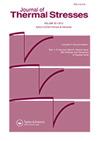Paradigm of Well-Orchestrated Pharmacokinetic Properties of Curcuminoids Relative to Conventional Drugs for the Inactivation of SARS-CoV-2 Receptors: An In Silico Approach
IF 2.6
3区 工程技术
Q2 MECHANICS
引用次数: 0
Abstract
To cure SARS-CoV-2 infection, the repurposing of conventional antiviral drugs is currently advocated by researchers, though their action is not very effective. The present study, based on in silico methods, was intended to increase the therapeutic potential of conventional drugs: hydroxychloroquine (HCQ), favipiravir (FAV), and remdesivir (REM) by using curcuminoids like curcumin (CUR), bisdemethoxycurcumin (BDMC), and demethoxycurcumin (DMC) as adjunct drugs against SARS-CoV-2 receptor proteins, namely main protease (Mpro) and the S1 receptor-binding domain (RBD). The curcuminoids exhibited similar pharmacokinetic properties to the conventional drugs. The webserver (ANCHOR) predicted greater protein stability for both receptors with a disordered score (<0.5). The molecular docking study showed that the binding energy was highest (−27.47 kcal/mol) for BDMC toward Mpro receptors, while the binding energy of CUR (−20.47 kcal/mol) and DMC (−20.58 kcal/mol) was lower than that of HCQ (−24.58 kcal/mol), FAV (−22.87 kcal/mol), and REM (−23.48 kcal/mol). In the case of S1-RBD, CUR had the highest binding energy (−38.84 kcal/mol) and the lowest was in FAV (−23.77 kcal/mol), whereas HCQ (−35.87 kcal/mol) and REM (−38.44 kcal/mol) had greater binding energy than BDMC (−28.07 kcal/mol) and DMC (−30.29 kcal/mol). Hence, this study envisages that these curcuminoids could be employed in combination therapy with conventional drugs to disrupt the stability of SARS-CoV-2 receptor proteins.姜黄素相对于传统药物在灭活SARS-CoV-2受体方面的精心安排的药代动力学特性范式:一种计算机方法
为了治疗SARS-CoV-2感染,研究人员目前提倡重新利用传统抗病毒药物,尽管它们的作用不是很有效。本研究基于计算机方法,旨在通过姜黄素如姜黄素(CUR)、双去甲氧基姜黄素(BDMC)和去甲氧基姜黄素(DMC)作为辅助药物对抗SARS-CoV-2受体蛋白,即主蛋白酶(Mpro)和S1受体结合结构域(RBD),提高传统药物羟氯喹(HCQ)、favipiravir (FAV)和remdesivir (REM)的治疗潜力。姜黄素表现出与常规药物相似的药动学特性。网络服务器(ANCHOR)预测两种无序评分(<0.5)的受体具有更高的蛋白质稳定性。分子对接研究表明,BDMC对Mpro受体的结合能最高(−27.47 kcal/mol),而CUR(−20.47 kcal/mol)和DMC(−20.58 kcal/mol)的结合能低于HCQ(−24.58 kcal/mol)、FAV(−22.87 kcal/mol)和REM(−23.48 kcal/mol)。在S1-RBD中,CUR的结合能最高(- 38.84 kcal/mol), FAV的结合能最低(- 23.77 kcal/mol),而HCQ (- 35.87 kcal/mol)和REM (- 38.44 kcal/mol)的结合能高于BDMC (- 28.07 kcal/mol)和DMC (- 30.29 kcal/mol)。因此,本研究设想这些姜黄素可用于与常规药物联合治疗,以破坏SARS-CoV-2受体蛋白的稳定性。
本文章由计算机程序翻译,如有差异,请以英文原文为准。
求助全文
约1分钟内获得全文
求助全文
来源期刊

Journal of Thermal Stresses
工程技术-力学
CiteScore
5.20
自引率
7.10%
发文量
58
审稿时长
3 months
期刊介绍:
The first international journal devoted exclusively to the subject, Journal of Thermal Stresses publishes refereed articles on the theoretical and industrial applications of thermal stresses. Intended as a forum for those engaged in analytic as well as experimental research, this monthly journal includes papers on mathematical and practical applications. Emphasis is placed on new developments in thermoelasticity, thermoplasticity, and theory and applications of thermal stresses. Papers on experimental methods and on numerical methods, including finite element methods, are also published.
 求助内容:
求助内容: 应助结果提醒方式:
应助结果提醒方式:


